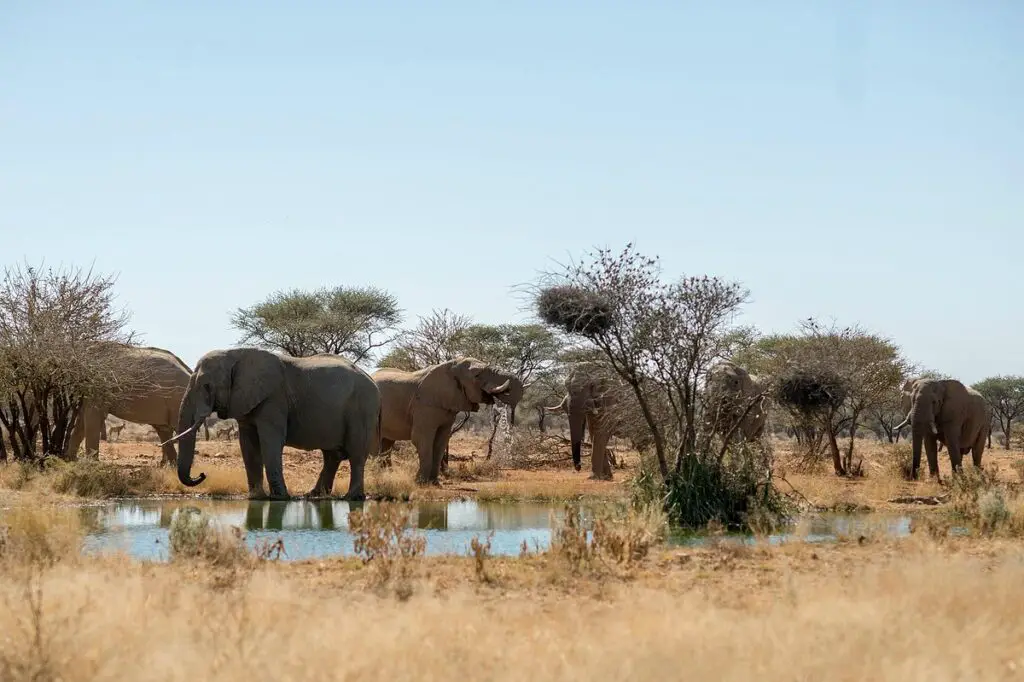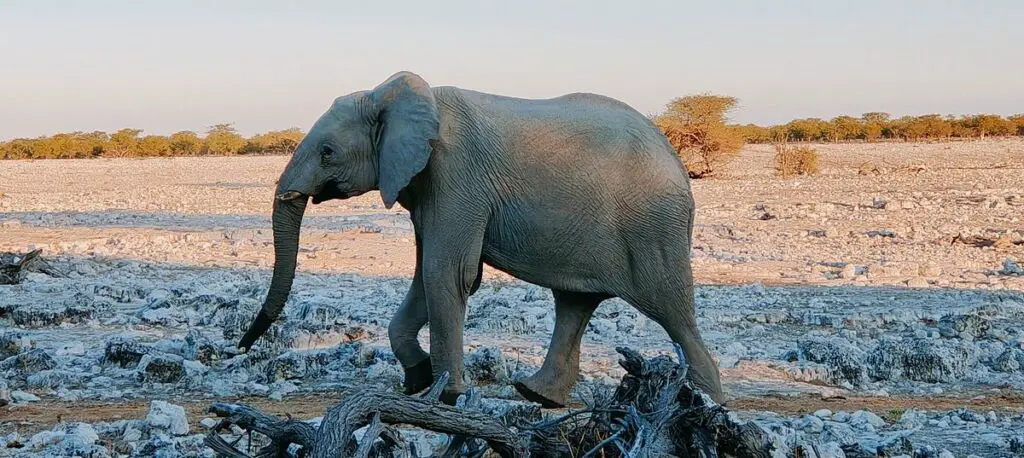Namibia’s desert elephants are a distinct and captivating population of African elephants (Loxodonta africana) that have adapted to survive in the challenging desert conditions of Namibia’s northwest region. Renowned for their resilience and unique behaviors, these elephants have captured the attention and admiration of researchers, conservationists, and visitors alike.
heir ability to navigate the arid landscape, endure water scarcity, and exhibit remarkable adaptations has made them a symbol of strength and adaptability in the face of challenging environments. The desert elephants of Namibia stand as a testament to the incredible diversity and adaptability of African wildlife.
In this article, we explore seven fascinating facts about these resilient creatures.
Unique Subspecies

Namibia’s elephants are not considered a unique subspecies but rather a distinct population of African elephants (Loxodonta africana) that have adapted to survive in the challenging desert conditions of Namibia’s northwest region. While they share similarities with other African elephant populations, the desert elephants of Namibia exhibit certain characteristics and behaviors that set them apart.
Desert elephants in Namibia tend to be smaller in size compared to their counterparts in other regions. This smaller stature is an adaptation to the scarce resources and arid conditions they face. They have longer legs and larger feet, which aid in traversing sandy terrains and searching for water sources.
Namibia’s desert elephants are known for their nomadic behavior and wide-ranging movements. They have the ability to travel extensive distances in search of food and water, as they need to constantly adapt to the ever-changing availability of resources in the desert environment.
Namibia’s desert elephants have adapted their behavior to cope with the desert conditions. They exhibit a more extensive home range compared to other elephant populations, as they need to cover larger distances to find food and water. They also have longer daily activity periods during cooler times, seeking shelter from the intense desert heat during the hottest parts of the day.
Can Endure The Desert Climate
Water is a precious resource in the desert, and Namibia’s desert elephants have evolved ways to conserve and utilize it effectively. They can go for several days without drinking, relying on moisture-rich vegetation as a source of hydration. They have specialized digestive systems that efficiently extract and retain water from the plants they consume.
These elephants have an incredible ability to locate water sources in the desert. They have an exceptional memory and can remember the locations of waterholes, rivers, and natural depressions where water accumulates during rainy periods. They rely on this knowledge to navigate and find water during times of scarcity.
Namibia’s desert elephants have adapted their diet to the limited food resources available in the desert. They are able to browse on a wide range of plant species, including drought-resistant shrubs, bushes, and trees. They have also developed the ability to dig for water-storing tubers and roots, using their tusks as tools to access these underground water sources.
Namibia’s desert elephants display behavioral adaptations to cope with the desert environment. They have been observed using their trunks to spray themselves with sand, which acts as a natural sunscreen, protecting their skin from the intense sun and preventing excessive moisture loss through evaporation.
Long-Distance Travel

Namibia’s desert elephants are known for their ability to cover vast distances in search of food and water. They have an extensive home range and can travel up to 70 kilometers (43 miles) in a single day. This long-distance movement allows them to access different water sources and vegetation patches, maximizing their chances of survival in the arid landscape.
he availability of resources in the desert is highly influenced by seasonal variations. During the dry season, when water and vegetation become scarce, the elephants may need to travel longer distances to find suitable forage and reliable water sources. By tracking changes in resource distribution, they can adapt their movements accordingly.
Elephants require significant amounts of water to sustain their large bodies and complex physiological processes. In the desert, where water sources are limited and sporadic, the elephants must move to access these crucial water supplies. They may travel to natural depressions, ephemeral rivers, or waterholes, sometimes covering considerable distances between these water sources.
Nocturnal Feeding
Namibia’s elephants, including the desert elephants, exhibit a behavior known as nocturnal feeding, where they primarily forage during the night and early morning hours. This behavior is influenced by several factors related to the desert environment and the elephants’ adaptations to survive in such conditions.
The desert regions of Namibia experience high temperatures during the day, making it challenging for elephants to actively forage and regulate their body temperature simultaneously. By feeding during the cooler night hours, they reduce the risk of overheating and heat stress associated with exertion and exposure to direct sunlight.
The desert vegetation in Namibia has adapted to survive in arid conditions. Many plant species in these regions have evolved physiological mechanisms to conserve water and reduce water loss during the day. By feeding during the cooler hours of the night, elephants can take advantage of the slightly higher moisture content in plants, making them more palatable and providing better nutritional value.
Namibia’s desert elephants often come into contact with human settlements and farmlands. By adopting nocturnal feeding habits, they can minimize conflicts with humans. Feeding under the cover of darkness reduces the likelihood of encountering humans and reduces the potential for crop raiding or other forms of human-wildlife conflict.
They are Smaller in Size
Namibia’s elephants, including the desert elephants, are generally smaller in size compared to other African elephant subspecies. This smaller size can be attributed to various factors related to their adaptation to the desert environment.
The arid desert environment of Namibia has limited vegetation and sparse food resources. The availability of nutrient-rich plants is often scarce, resulting in reduced nutritional intake for elephants. Insufficient nutrition during critical growth stages can lead to smaller overall body size.
The smaller body size of Namibia’s elephants is advantageous in terms of heat dissipation and thermoregulation in the desert environment. Larger bodies tend to generate and retain more heat, which can be detrimental in the extreme temperatures of the desert. Smaller bodies have a larger surface area relative to their volume, enabling more efficient heat dissipation and reducing the risk of overheating.
The smaller size of Namibia’s elephants can also be attributed to genetic factors specific to this population. Over time, the elephants in Namibia’s desert may have undergone evolutionary changes, including genetic variations that favor smaller body size as an adaptation to the arid conditions.
Have Adapted to Water Scarcity
Namibia’s elephants have the ability to store and retain water within their bodies. They can drink large quantities of water when it is available and store it in their digestive system, tissues, and specialized body structures. This allows them to sustain themselves for extended periods without immediate access to water.
During dry periods, when water sources are scarce, Namibia’s elephants rely on consuming moisture-rich vegetation. They have adapted to identify and consume plants that contain higher water content, helping to fulfill their water requirements to some extent.
Namibia’s elephants use their tusks and feet to dig for water in dry riverbeds, known as ephemeral rivers, or in areas where water accumulates underground. By excavating these areas, they can access water that is stored in the sand or hidden in underground pockets.
Namibia’s elephants display water conservation behavior to minimize water loss. During times of scarcity, they reduce unnecessary water expenditure, such as limiting bathing or splashing activities. Additionally, they tend to be more active during cooler periods of the day to minimize water loss through evaporation.
They are Remarkable Foragers

Namibia’s desert elephants have a flexible and diverse diet. They are capable of consuming a wide variety of plant species, including drought-resistant shrubs, bushes, trees, and succulents. This broad dietary range allows them to adapt to the changing availability of vegetation in the desert and utilize different plant species for sustenance.
In times of scarcity, Namibia’s desert elephants have the ability to strip bark from trees and bushes. They use their powerful trunks and tusks to remove the outer bark, revealing the nutrient-rich inner layers. This behavior provides them with a valuable food source, especially during dry periods when other vegetation may be less abundant.
Namibia’s desert elephants have a keen understanding of the relationship between water sources and food availability. They actively seek out vegetation that thrives near water sources, such as rivers and ephemeral riverbeds. These areas often have higher plant density and offer more moisture-rich food options.
Namibia’s desert elephants are a testament to the incredible resilience and adaptability of nature. Thriving in the desert landscapes of Namibia, these majestic creatures have captivated the world with their unique characteristics and challenges. By embracing sustainable conservation practices and promoting responsible tourism, we can ensure the long-term survival of Namibia’s desert elephants and protect this extraordinary species for generations to come.

